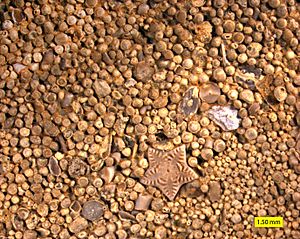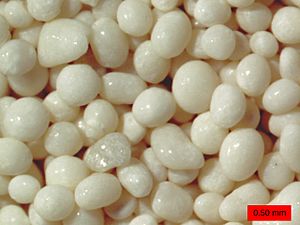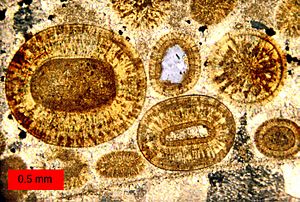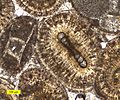Ooid facts for kids

An ooid is a very small, round piece of sedimentary rock. Think of them like tiny pearls, but made of rock! They are usually less than 2 millimeters across, which is about the size of a pencil tip. If these grains are larger than 2 millimeters but formed in the same way, they are called pisoids. When lots of ooids are stuck together, they form a type of rock called oolite.
Contents
What Are Ooids?
Ooids are special because they are perfectly round and have many layers, like an onion. These layers build up around a tiny center, which could be a piece of shell, a sand grain, or even a tiny bit of a fossil. They are mostly made of calcium carbonate, which is the same material found in seashells and chalk.
How Do Ooids Form?
Ooids form in very specific places, usually in warm, shallow ocean water. The water needs to be moving a lot, like in waves or currents. Here's how it happens:
- A tiny particle, like a sand grain, starts rolling around on the seafloor.
- As it rolls, layers of calcium carbonate stick to it from the water.
- This process continues, adding more and more layers, making the grain grow bigger and rounder.
- It's like a tiny snowball rolling down a hill, picking up more snow as it goes!
This constant rolling and layering is what gives ooids their unique round shape and many layers.
Where Can We Find Ooids?
You can find ooids forming today in places like the Bahamas and the Persian Gulf, where the water is warm and shallow. But ooids are also found in very old rocks, showing us what ancient environments were like.
- Many limestone rocks around the world are made of ooids.
- These ancient oolite rocks tell scientists about past oceans and climates. They show us where shallow, warm seas once existed millions of years ago.
Why Are Ooids Important?
Ooids are important for several reasons:
- Clues to the Past: By studying ooids in old rocks, scientists can learn about ancient environments, like how warm the water was or how strong the currents were. They act like tiny time capsules!
- Natural Resources: Sometimes, the spaces between ooids in oolite rocks can hold important natural resources like oil and natural gas. This makes oolite a valuable rock for energy exploration.
- Building Materials: Oolite is also used as a building stone in many parts of the world because it is strong and beautiful.
Images for kids





